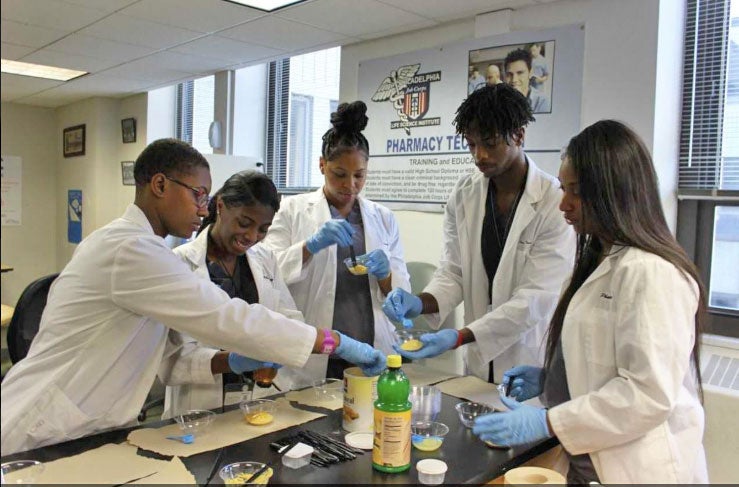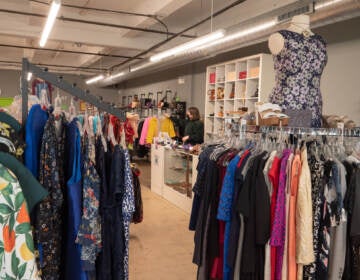Breaking Poverty: A need to create access to jobs, training
Positive male influences were hard to come by in Nyhein Webb’s Southwest Philadelphia neighborhood.

Students participate in a CVS Pharmacy technician apprenticeship program at Philadelphia Job Corps. The program is supported by federal training dollars (Courtesy of Philadelphia Works)
This story originally appeared on The Philadelphia Tribune.
—
Positive male influences were hard to come by in Nyhein Webb’s Southwest Philadelphia neighborhood.
“Basically, everybody just looks up to what you see in your environment,” said Webb, who lives with his grandmother.
“A lot of my friends have single-parent households where their dad is locked up or he died in the streets and it’s just their mom. We didn’t have positive male models.”
After Webb saw several young men in his community go to prison or lose their lives to violence, he decided he needed to follow a different path.
He signed up for Year Up, a national workforce development program that connects urban young adults aged 18 to 24 with companies who need their talent.
Year Up is one of many initiatives — including one funded by the city and another funded by town-gown partnerships — that aim to connect local residents with living wage jobs.
Earlier this year, Mayor Jim Kenney launched a citywide workforce development strategy that seeks to address the poverty that is impacting Philadelphia. The initiative focuses on three goals: preparing Philadelphia residents with the skills employers need, addressing barriers that prevent people from accessing meaningful opportunities, and ensuring the city’s workforce system is more coordinated and effective. The strategy calls for $13 million to be invested annually in workforce education and training to prepare Philadelphia residents for middle-skills jobs.
The new strategy is being overseen by the Office of Workforce Development.
“I think that one of the charges of this office is to engage employers to be able to speak to the systems that we have created in Philadelphia so that people on every rung in the ladder of their career get the support that they need,” said the office’s Executive Director Sheila Ireland.
“The charge of this office is to build a pathway for folks so wherever they are in their careers they have some understanding of how to get to the next level.”
City officials are working with business leaders to establish or expand industry partnerships in seven opportunity industries identified by the Economy League of Greater Philadelphia, including health care, retail and hospitality, early childhood education, technology services, business and financial services, construction and infrastructure, and manufacturing and logistics.
The middle-skills job gap
Meg Shope Koppel, chief research officer of Philadelphia Works, a nonprofit organization that funds and oversees employment and training services, said there is a huge demand for employees to fill middle-skill jobs, which require education beyond high school but not a four-year degree.
“Middle-skill positions really have a range of post-secondary credentialing, vocational programs or two-year degrees and they can result in some really high-paying jobs,” Koppel said.
“We know that there is huge opportunity in this city for middle-skills (jobs) that are not being filled right now. We also know that a lot of our retail and hospitality workers are not going to stay in those fields and that work experience in and of itself, is really valuable and can be converted into a good starting point for them training to move into skilled jobs.”
The largest occupations in the metro area with a median wage above $15 an hour that don’t require a bachelor’s degree include general office clerks, customer service representatives, secretaries and administrative assistants, front line office supervisors, bookkeepers, accounting and auditing clerks, wholesale and manufacturing sales representatives, heavy and tractor-trailer truck drivers, and general maintenance and repair workers, according to a Federal Reserve Bank of Philadelphia analysis of data from the Bureau of Labor Statistics.
“I think opportunity is driven by three things,” said Keith Wardrip, community development research manager of the Philadelphia Fed.
“The availability of the jobs in the region and what do they pay being the first factor. The second is the skills present in the labor force and the third is how the match is made between workers looking for jobs and employers trying to hire.”
The education gap
Many employers often recruit workers from the traditional pool of young graduates with four-year degrees, said Malik Brown, Associate Vice President of Workforce Solutions and Community Impact at Peirce College.
While the percentage of African Americans with college degrees are growing, a racial gap still remains in educational attainment. A 2016 U.S. Census Bureau report indicates that just 23 percent of African Americans have a college degree.
Brown said the higher education and employer communities should look at nontraditional populations through a different lens.
Peirce encourages its corporate partners to consider hiring adults with more than 10 years of working experience who don’t have a college degree but may be working toward earning it.
“That is very different value proposition because it’s getting companies to think and behave differently around how they attract talent and how to strategically think about partnering with organizations like Peirce around talent,” Brown said.
“We’ve taken a different approach to really go in, get the know the (industries) get to know our regional employers and really get them to see the value of bringing in someone who is 35-to-40-years-old, (has) 10 to 15 years of experience and really see them as a strategic part of their talent pool or talent pipeline.”
Brown noted that 70 percent of Peirce’s students are African American and many are working adults from lower socioeconomic backgrounds.
Peirce has training initiatives that focus on getting long-term unemployed adults back into the workforce, Brown said. One example is the Urban Tech Jobs program, a partnership between Peirce and the Urban League of Philadelphia, that offers accelerated IT training and work with a career and life coach.
“STEM (science, technology, engineering and math) fields have the highest earning potential and they also have the lowest unemployment rate and also the highest rates when it comes to job expansion over the next couple of years,” said Sherry Wherry, program manager, Urban Tech Jobs.
“Getting an IT job is really the best opportunity for a client who’s looking to keep up in the times that we are in. When you look at society as a whole, everything is technology driven.”
Recognizing that the health care is another burgeoning sector, Peirce recently launched a free 10-week training session for low- to moderate-income adults with at least one child that is supported by a $60,000 grant from United Way. Participants learn skills needed for customer service positions in the non-clinical health care industry. According to Brown, these positions often pay a starting salary upwards of $39,000 annually.
Peirce faculty and career development office administrators are leading course instruction in areas such as customer service and emotional intelligence. Participating students receive financial literacy training, parenting support services and mental and emotional wellness support.
Bridging the gaps
Nyhein Webb was enrolled in the Year Up program for a year. The program paid for him to take business courses at Peirce College and set him up with an internship at wealth management firm BNY Mellon in King of Prussia.
Webb graduated from the program in July and scored a good-paying job offer with BNY Mellon. The 20-year-old currently works full time in the company’s fraud department.
“Without Year Up, I know that I probably wouldn’t have gotten this offer,” said Webb, who is a graduate of Murrell Dobbins Career and Technical Education High School.
“Year Up has been a big help. This is big because most people go to college for four years and get an opportunity like this, and Year Up was able to grant me this opportunity in one year and I don’t have a degree.”
Webb plans to return to Peirce College to pursue his bachelor’s degree in business and eventually become an entrepreneur.
Webb also wants to be a positive force in his community.
He lost two friends to violence while he was in the Year Up program.
He wants to show the youth in his neighborhood what can come from going to school and getting an education.
“I just try to talk to the young kids in my neighborhood and guide them away from the streets,” he said.
Melinda Brown, site director of Year Up Greater Philadelphia, said the program is instrumental in closing the opportunity divide and connecting young adults without college degrees to good-paying jobs.
Ninety percent of the initiative’s graduates are employed and or enrolled in post-secondary education within four months of completing the program, according to Year Up’s website. Employed graduates earn an average starting salary of $38,000 per year.
Working on more bridges
About 40 years ago, half of the jobs in the five-county region were in the city, said John Dodds, executive director of the Philadelphia Unemployment Project. Now only about 25 percent are in the city and the rest are in the surrounding counties.
Dodds said about 32 percent of the jobs in the region don’t require a college degree and about 190,000 people are “reverse commuting” — commuting from the city to the suburbs — for work.
Some commuters face the challenge of having to ride multiple SEPTA buses to get to job sites in the suburban counties and some bus schedules are not convenient for workers who have late schedules. It takes about 90 minutes on SEPTA to commute to 75 percent of the suburban jobs.
“What we really need to do as a city and a region is to figure out how to make these jobs accessible to people that don’t have cars and are dependent on mass transit,” Dodds said. “The real issue is the mass transit system was designed in 1970 when all the jobs were in the city and everybody was coming in, and it worked very well.”
The Philadelphia Unemployment Project has been advocating for funding to support reverse commute options for inner city residents. The organization recently announced that the City Council budget contained an appropriation of $55,000 for its commuter options program that provides cars and vans to local residents so they can carpool to work in the suburbs.
“Nobody has really had an answer for reducing poverty,” Dodds said. “There is no one thing that is going to solve all the problems, but we feel like this would be a good step if we could dramatically increase people’s access to these opportunities in the suburbs.”
—
 WHYY is one of 19 news organizations producing Broke in Philly, a collaborative reporting project on solutions to poverty and the city’s push towards economic justice. Follow us at @BrokeInPhilly
WHYY is one of 19 news organizations producing Broke in Philly, a collaborative reporting project on solutions to poverty and the city’s push towards economic justice. Follow us at @BrokeInPhilly
WHYY is your source for fact-based, in-depth journalism and information. As a nonprofit organization, we rely on financial support from readers like you. Please give today.




